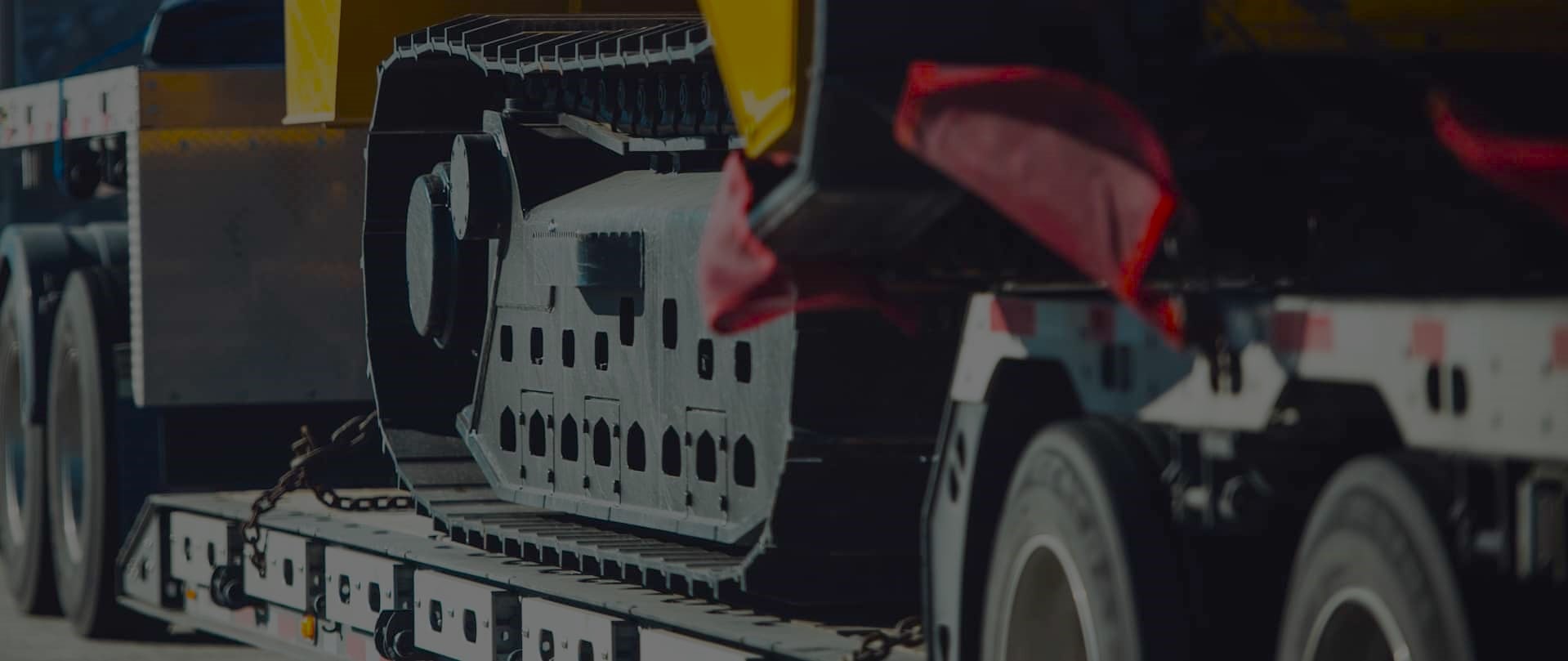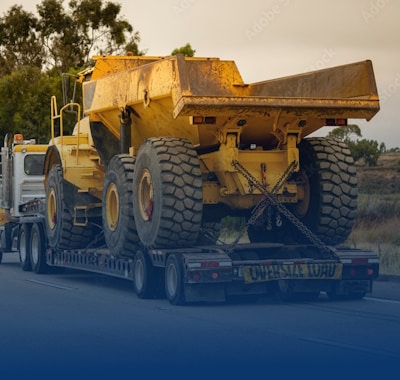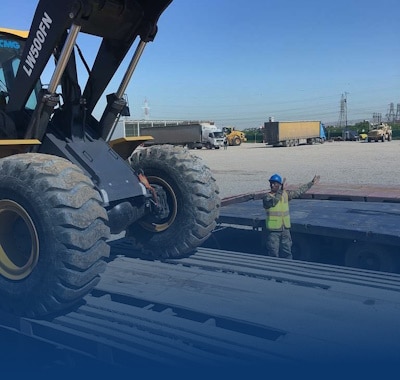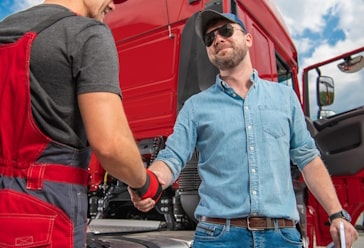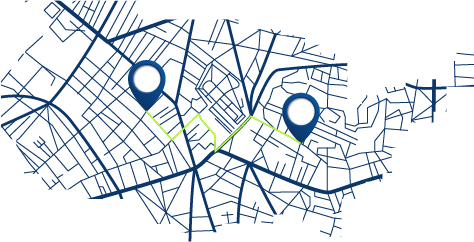Reliable Heavy Haul Trucking for Mining Equipment Needs
Freedom Heavy Haul can offer expedited Pickup and Delivery for any size shipment anywhere in the USA. Contact us today for No Hassle, No Pressure Pricing.
Moving mining equipment safely needs special skills. Heavy haul trucking companies handle big loads like excavators and drills. They make sure the equipment gets there safely, on time, and follows the law.
Going with heavy equipment transport companies lowers risks. They take care of permits, plan routes, and follow safety rules. This article talks about how these carriers face challenges, follow rules, and use tech for better mining logistics.
Understanding the Complexities of Mining Equipment Transportation
Transporting mining equipment needs careful planning and skill. Specialized movers handle the challenges of size, weight, and rules. They ensure safe delivery of everything from big excavators to small processing units.
Types of Mining Equipment Requiring Specialized Transport
Mining uses heavy machinery that needs special transport. Here are some examples:
- Hydraulic shovels (50–100 tons): Need special trailers for moving.
- Haul trucks (80–400 tons): Require strong axles and extra wheels.
- Drill rigs: Must be moved carefully to avoid damage.
| Equipment | Weight Range | Transport Solution |
|---|---|---|
| Mobile Crushers | 20–200 tons | Step-deck trailers with permits |
| Draglines | 1,000+ tons | Customized modular transporters |
| Conveyor Systems | Varies | Componentized shipping |
Unique Challenges in Mining Equipment Logistics
Logistics experts face many challenges. These include restricted routes, weather, and tight deadlines. They often need:
- Escort vehicles for big or tall loads.
- Transporting at night to avoid traffic.
- Doing detailed safety checks for remote areas.
Industry Safety Standards and Compliance Requirements
“Safety isn’t negotiable. Every load must meet DOT regulations and state-specific guidelines.”
Following safety rules is key. This includes using strong chains, doing safety checks before moving, and training staff. Experts also keep up with new rules, like limits on vehicle emissions near protected areas.
Heavy Haul Trucking Companies for Mining Equipment: What Sets the Best Apart
Not all heavy haul providers are the same when it comes to mine equipment trucking. The top companies mix long experience with the latest technology. This way, they efficiently move oversized mining equipment. Here’s what makes them stand out:
- Proven Expertise: Companies like Mammoet and Emmert International have been moving huge mining machines for over 50 years. They know how to handle tough routes and rules.
- Specialized Fleet: They use special trailers, platforms, and transporters. This ensures safe transport of heavy machines like 200-ton excavators or 40-foot crushers.
- Safety First: They have no accident records and follow all DOT rules. This shows they care about safety.
“Partnering with a carrier that understands mining logistics prevented costly downtime during our Alberta oil sands project.” – Rio Tinto Logistics Team
Leading providers also use the latest GPS tracking and have teams for permits. For example, Goldhofer’s THP/SL series trailers fit odd shapes. ALE Heavylift uses hydraulic axles to balance weight.
| Company | Years Operating | Specialty |
|---|---|---|
| Mammoet | 60+ | Mega-Project Relocations |
| Emmert International | 45+ | Cross-Border Permitting |
| Goldhofer | 50+ | Custom Modular Trailers |
When picking mine equipment trucking services, check their safety record, insurance, and what others say. The right partner helps avoid delays, keeps things safe, and stays within budget. This is key for today’s mining projects.
Essential Equipment and Capabilities for Mining Transport
Moving mining machinery needs precise tools and skill. Experts use special gear to safely transport heavy loads over tough terrains. Each piece, from custom trailers to safety systems, is vital for a successful delivery.
Specialized Trailer Types and Their Uses
Mining transport pros use trailers made for specific jobs:
- Lowboy trailers: Great for tall machines like excavators or crushers.
- Modular trailers: Can adjust to fit odd-shaped loads, like conveyor systems.
- Step-deck trailers: Good for smaller machines like drills or generators.
| Trailer Type | Common Use | Max Capacity (tons) |
|---|---|---|
| Multi-Axle Lowboy | Draglines, shovels | 400 |
| Hydraulic Modular | Oversized processing units | 1,200 |
| Extendable Flatbed | Drilling rig components | 250 |
Weight Capacity Considerations
Getting the weight right is key to avoid damage and follow rules. Shippers check the trailer’s setup, load balance, and local laws. For example, a big 900-ton crusher might need a 24-axle trailer to stay within weight limits.
Advanced Safety Features and Technology
Today’s transport uses advanced tech like:
- Real-time load monitoring sensors
- Automatic emergency braking
- 360-degree camera arrays
“Safety protocols for oversized loads mandate continuous GPS tracking and escort vehicles in 85% of U.S. states.” – National Heavy Haul Association
Experts mix these techs with thorough training to cut down risks on the road.
Planning and Executing Mining Equipment Moves
Moving mining machinery needs careful planning. Heavy haul trucking companies focus on planning every detail. They consider the size of the equipment and the road conditions. “A single oversight can delay projects by weeks,” says a logistics manager at a leading transport firm.
Effective planning includes:
- Working with heavy equipment transport companies to plan routes that avoid low bridges or weak infrastructure
- Scheduling moves during times when there is less traffic to cause fewer disruptions
- Getting permits for oversized loads, which experienced partners often handle
“Transporting a 200-ton excavator isn’t just about driving—it’s about synchronizing teams, permits, and technology. Partnering with experts ensures compliance and safety.”
Execution needs to be flexible. Weather changes, road closures, or changes in equipment plans can affect timelines. Heavy haul trucking companies use GPS tracking and real-time communication to adjust plans quickly. For example, moving a Komatsu PC8000 shovel might require a new route if a bridge’s weight limit changes unexpectedly.
Heavy equipment transport companies also focus on safety during loading and unloading. They use hydraulic trailers, specialized rigging, and trained crews to reduce risks. Caterpillar 797F mining trucks, which weigh over 1.2 million pounds, need custom solutions that only seasoned providers can offer.
By combining careful planning with flexible execution, mining operations stay productive. Relying on professionals ensures that machinery arrives safely, on time, and within budget.
Route Planning and Permit Requirements
Moving mining machinery needs careful planning. It involves understanding laws and the terrain. Specialized movers must keep up with changing rules, weight limits, and road conditions.
State-by-State Regulations
Permit rules change from state to state. Texas lets 14-foot wide loads with 48 hours’ notice. California requires 72-hour advance applications for loads over 12 feet. To avoid problems, movers use tools like the Federal Highway Administration’s bridge formula calculator.
| State | Max Width | Escort Vehicles | Permit Cost |
|---|---|---|---|
| Nevada | 16 ft | 2 | $150 |
| Arizona | 14 ft | 1 | $225 |
| Colorado | 12 ft | 3 | $300 |
Oversized Load Requirements
Haulers need to install:
- Red/amber warning flags
- LED clearance lights
- State-approved height poles
Mining equipment logistics specialists work with DOT offices. They get permits for loads over 80,000 pounds.
Timing and Scheduling Considerations
Winter bans in Montana and spring thaw in Minnesota need careful planning. Movers use geofencing software to track weather. They also plan night transport for safety near schools.
“Route planning isn’t just maps – it’s predicting how 17 counties will interpret ‘oversize’ by Tuesday.” – Caterpillar Transport Partner
Working with logistics specialists helps meet deadlines. They turn complex rules into manageable steps.
Cost Factors in Mining Equipment Transportation
Transporting mining machinery involves many variables that affect prices. Knowing these factors helps companies plan their budgets better. This ensures safe delivery through reliable mine equipment trucking services. Here are the main elements that shape transportation costs.
Distance and Route Variables
Longer trips usually cost more because of fuel, labor, and wear on equipment. Routes that need detours for oversized load hauling for mining equipment often have extra costs. These include:
- Permit fees for crossing state lines
- Escort vehicles for narrow roads
- Overnight stops in restricted zones
“Route complexity can double costs in mountainous regions compared to flat terrains. Always request a route analysis before finalizing contracts.”
Equipment Size and Weight Impact
Heavier machinery needs special trailers and strong axles. For instance, a 200-ton excavator might need:
- Multi-axle lowboy trailers
- State-approved weight distribution plans
- Road reinforcement permits
These needs directly impact the cost of mine equipment trucking services.
Additional Services and Their Costs
Besides basic transport, oversized load hauling for mining equipment may include:
- Rigging and crane assistance ($500–$2,000/day)
- Expedited delivery surcharges (15–30% premium)
- Custom crating for fragile components
Working with experienced providers ensures clear quotes and avoids hidden fees.
Safety Protocols and Risk Management
Shipping mining equipment needs strict safety steps to protect everyone and the cargo. Experts in this field use special protocols to handle risks. They use the latest tech, training, and follow rules to keep operations safe.
Important safety steps include:
- Checking equipment before moving to make sure it’s stable and the trailer is good
- Using GPS to track the route and watch for dangers
- Having safety talks for drivers and the team at the site
- Having plans ready for emergencies with big loads
“Safety isn’t just a checklist—it’s a culture. Every team member must anticipate risks before they escalate,” notes a safety officer at a leading transport firm.
Experts in moving mining gear follow OSHA and the Department of Transportation rules. They check to make sure everything is within limits and safe. Tools like systems to watch for driver fatigue and tech to avoid crashes help keep things safe on long trips.
Working with pros in moving mining gear lowers risks. They offer training and insurance to protect everyone. They always look for ways to get better, using data to improve their safety plans. This way, they avoid problems and keep projects on track.
Choosing the right team for moving mining gear means your project will run smoothly. They make sure everything is done right and safely.
Environmental Considerations in Heavy Equipment Transport
As industries focus on being green, heavy haul trucking companies for mining gear are under more pressure. They must lessen their impact on the environment. Now, forward-thinking companies use new ways to meet their needs while caring for the planet. This helps keep ecosystems and communities safe.
Fuel Efficiency Measures
Modern fleets use new tech to use less fuel without losing power. Some key improvements include:
- Aerodynamic truck designs that reduce drag
- Low-rolling-resistance tires improving mileage
- GPS route optimization to avoid idling and detours
Companies like Caterpillar use eco-mode engines that save fuel. Komatsu’s hybrid excavators show how to cut emissions during certain tasks.
Minimizing Environmental Impact
Top heavy equipment transport companies also take steps to protect the environment. They use spill containment systems and biodegradable lubricants. Mammoet, a global leader, works with reforestation programs to offset carbon emissions from big moves.
“Sustainability isn’t optional—it’s in every transport plan we make. We use solar-powered lighting and recycle packing materials. Our aim is to leave as little trace as possible,” says a Mammoet project manager.
Working with eco-friendly heavy haul trucking companies for mining gear helps businesses meet rules and protect the environment. This shows that growth and caring for the planet can go hand in hand.
Insurance and Liability Coverage for Mining Equipment Transport
Moving big mining machines needs more than just strong trailers. It also needs solid insurance. Specialized movers focus on strong policies to guard against surprises. This includes damage to parts or accidents on the road, keeping projects on track and on budget.
- Liability Insurance: Covers third-party injuries or property damage during transit.
- Cargo Insurance: Safeguards equipment against theft, collisions, or environmental hazards.
- Equipment Insurance: Addresses repair or replacement costs for transported machinery.
| Coverage Type | Key Protections | Ideal For |
|---|---|---|
| General Liability | Legal fees, third-party claims | Public road transport |
| All-Risk Cargo | Full-value equipment replacement | High-value machinery |
| Inland Marine | Off-road and site-related damages | Remote mining sites |
“A single uncovered incident can derail a project for months. Partnering with mining equipment logistics specialists who carry layered policies is non-negotiable.”
Insurance costs change based on what’s being moved, how far it’s going, and local laws. Logistics experts often combine policies to save money while keeping important protections. To find the best deals, compare heavy haul insurance quotes from those who know mining risks well.
Top transport companies use safety tech like GPS and collision systems to cut down on risks and costs. Always check a mover’s insurance certificates and ask for policy updates yearly to keep coverage current with your needs.
Technology Integration in Modern Mining Equipment Logistics
Modern mine equipment trucking services use advanced technology. This includes GPS tracking, digital documentation, and real-time communication. These tools help meet today’s high standards for precision and reliability.
GPS Tracking and Real-Time Updates
GPS systems give minute-by-minute location data. This lets logistics teams track routes and adjust for delays. Real-time updates also help drivers, mining sites, and traffic authorities stay in sync. This reduces downtime and ensures safe, on-time delivery of oversized loads.
Digital Documentation Systems
Digital platforms have replaced paper-based processes. They handle permits, weight certifications, and safety checks online. The benefits are:
- Less chance of administrative errors
- Quicker approval times
- Secure cloud storage for audits
These systems keep oversized load hauling for mining equipment up to date with changing regulations.
Communication Protocols
Unified communication tools connect everyone involved. They send instant alerts for route changes, weather hazards, or equipment issues. This prevents costly mistakes. For mine equipment trucking services, it reduces risks and boosts transparency.
| Aspect | Traditional Approach | Tech-Driven Approach |
|---|---|---|
| Tracking | Manual check-ins | GPS real-time data |
| Documentation | Paper files | Digital platforms |
| Communication | Phone/radio updates | Integrated messaging systems |
Companies that invest in these technologies lead the way in efficiency. They offer safer, faster, and more cost-effective solutions for oversized load hauling for mining equipment.
Working with Professional Mining Equipment Haulers
Working with professional mining equipment shippers means your gear gets to its destination safely and on time. They handle big loads, follow all the rules, and offer custom solutions for tricky logistics. A good relationship with these experts lowers risks and makes your projects run smoother.
Selecting the Right Transport Partner
Finding a trustworthy hauler is key. Look for these important qualities:
- Industry experience: Companies with a solid history in moving mining equipment.
- Certifications: They should follow DOT, FMCSA, and state rules.
- Equipment capabilities: They need trailers that can carry big machines like excavators and drills.
- Insurance coverage: They should have good insurance for any damage or delays.
“Freedom Heavy Haul gives quick quotes and custom plans for big industrial jobs. See how they make moving big mining equipment easier.”
Communication Best Practices
Good communication stops delays and mix-ups. Here’s how to do it:
- Share details early: Give them the size, weight, and when and where to pick up and drop off.
- Confirm updates: Ask for updates and for the driver to check in.
- Document everything: Go over contracts, permits, and insurance together.
Professional mining equipment shippers value being open to build trust. Experts like Freedom Heavy Haul use digital tools to keep clients in the loop. This way, every shipment meets safety and timing goals.
Partner with Expert Mining Equipment Transportation Specialists Today
Choosing the right heavy haul trucking companies for mining equipment is key. Leaders like Mammoet and Barnhart show how important it is to manage oversized loads well. They use special trailers and route planning to overcome tough terrain and get permits.
Top companies focus on safety and follow OSHA and DOT rules. They have strong trailers and systems to watch the load in real-time. Working with them means less downtime and following the law.
Today, companies use new tools to get permits faster and cut down on emissions. This change helps the environment without losing the ability to move big equipment. Planning ahead with transport experts is essential for moving heavy machinery quickly.
Looking to improve your mining logistics? Reach out to trusted heavy haul trucking companies like Alleghany Transport or Daseke. They offer tailored solutions and are available 24/7. Their teams make sure your equipment gets there safely and on time.
